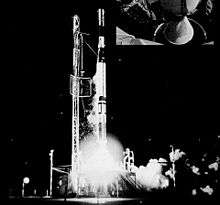Vanguard SLV-1
Vanguard SLV-1, also called Vanguard Satellite Launch Vehicle-1 was hoped to be the second successful flight of the American Vanguard rocket following the successful launch of the Vanguard 1 satellite on rocket Vanguard TV-4 in March 1958. Vanguard SLV-1 launched on 27 May 1958 at 03:46 GMT. It was launched from Launch Complex 18A at the Cape Canaveral Air Force Station. At second stage separation, there was a momentary pitching motion registered by the rate gyros which resulted in an incorrect attitude reference. The second stage placed the third stage on a trajectory approximately 63° up from the intended flight path. It arced upward and reached a peak altitude of 3500 kilometers before reentering and breaking up over South Africa. The pitching motion was deemed to be a rupture in the second stage engine thrust chamber due to high-frequency combustion instability at engine shutdown. On subsequent flights, the second stage was modified to prevent the possibility of an oxidizer-rich shutdown. [1] [2] [3][4] [5]

Vanguard SLV-1 carried the Vanguard 2B satellite, equipped with Lyman Alpha ultraviolet detectors and a magnetosphere measurement device. The satellite payload weighed 9.75 kg (21.5 lb). The rocket reached an apogee (the highest point of the rocket's flight) of 3,500 km (2,200 mi).[6]
See also
References
Further reading
- Mallove, Eugene F. and Matloff, Gregory L. The Starflight Handbook: A Pioneer's Guide to Interstellar Travel, Wiley. ISBN 0-471-61912-4.